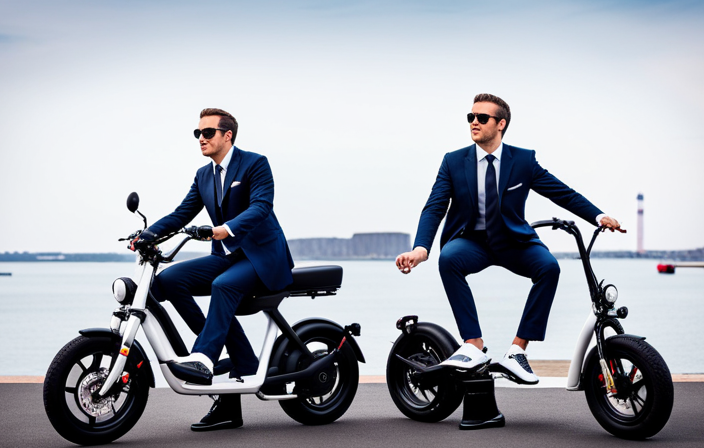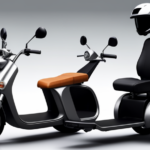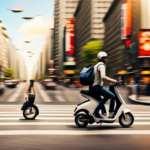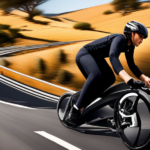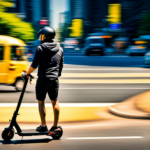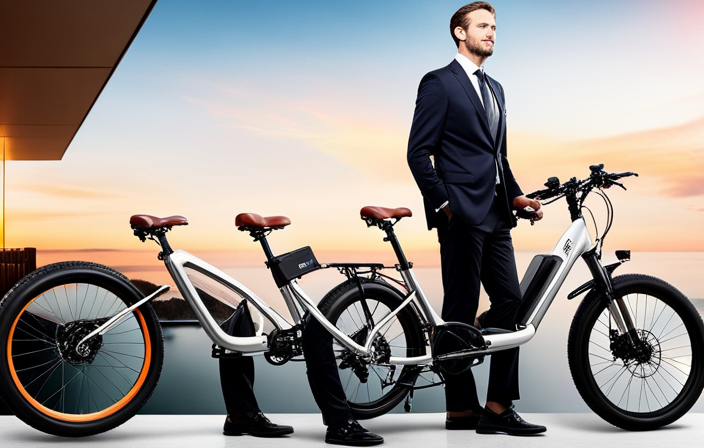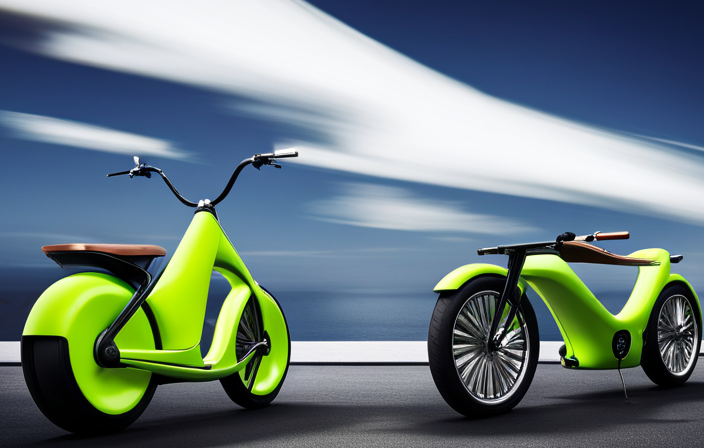In 2020, more than 2.1 million electric bikes and scooters were sold globally. As the popularity of these two-wheeled vehicles continues to rise, it’s crucial to determine which one is safer.
In this article, we will analyze the data and explore various factors such as speed, stability, maneuverability, safety features, and road regulations to determine which option provides a safer riding experience.
So, let’s dive in and find out whether an electric bike or scooter is the safer choice.
Key Takeaways
- Electric bikes have shorter braking distances, reducing accident risks.
- Electric bikes have headlights, taillights, and turn signals for enhanced visibility.
- Electric bikes offer a safer riding experience.
- Scooters have larger wheels which enhance stability and reduce the risk of tipping over.
Speed Comparison
If you’re comparing speed, an electric bike is generally faster than a scooter. When it comes to acceleration capabilities, electric bikes have the upper hand. With their powerful motors, they can quickly reach high speeds, allowing riders to navigate through traffic more efficiently.
Scooters, on the other hand, have a slower acceleration due to their smaller engines. Additionally, electric bikes tend to have a shorter braking distance compared to scooters. This means that in emergency situations, electric bike riders can come to a stop more quickly, reducing the risk of accidents.
Now, let’s move on to the next section where we will analyze the stability of electric bikes and scooters.
Stability Analysis
To determine the stability of the two options, you should consider factors such as balance and maneuverability. When conducting a stability assessment, it is important to take into account the design and construction of both electric bikes and scooters. Here are five key factors to consider in a risk assessment:
- Wheelbase: The distance between the front and rear wheels affects the stability of the vehicle.
- Center of gravity: A lower center of gravity enhances stability, reducing the risk of tipping over.
- Suspension system: A well-designed suspension system can absorb shocks and provide better stability on uneven surfaces.
- Tires: The type and quality of tires play a crucial role in providing grip and traction, enhancing stability.
- Frame material: The material used in the construction of the frame can impact stability and durability.
Considering these factors, it is essential to conduct a thorough stability assessment when comparing electric bikes and scooters.
This assessment leads us to the subsequent section about maneuverability evaluation.
Maneuverability Evaluation
When evaluating the maneuverability of both options, it is important to consider factors such as turning radius and agility. The maneuverability benefits of electric bikes include a smaller turning radius, making them more agile and easier to navigate through tight spaces. On the other hand, electric scooters have a wider turning radius, which may limit their ability to maneuver in crowded areas. To further illustrate this, let’s compare the two options in a table:
| Electric Bike | Electric Scooter | |
|---|---|---|
| Turning Radius | Smaller | Wider |
| Agility | More Agile | Less Agile |
By analyzing these factors, it becomes clear that electric bikes have an advantage in terms of maneuverability. However, it is important to note that both options have their limitations. The subsequent section will delve into the safety features of each option, providing a comprehensive analysis of their overall safety.
Safety Features
When discussing safety features, it’s important to consider both electric bikes and scooters.
Electric bikes often come equipped with safety features such as headlights, taillights, and turn signals. These features enhance visibility and help prevent accidents.
Similarly, scooters may have safety features like anti-lock braking systems and rearview mirrors. These features contribute to a safer riding experience.
Overall, the significance of these safety features cannot be understated. They play a crucial role in preventing accidents and ensuring the well-being of riders.
Safety features of electric bikes
The safety features of electric bikes include built-in headlights and taillights, which enhance visibility for both the rider and other road users. Additionally, electric bikes are equipped with stability features, such as wider tires and a lower center of gravity, which contribute to better balance and control. These stability features help reduce the risk of accidents, especially when navigating corners or uneven terrain.
Another crucial safety aspect is the braking system. Electric bikes often come with hydraulic disc brakes, which provide reliable and efficient stopping power. These brakes are responsive and offer better control over the bike’s speed, ensuring a safer riding experience.
As we transition to the subsequent section about the safety features of scooters, it is important to compare and analyze how these features differ and contribute to overall safety.
Safety features of scooters
One important aspect of scooter safety is the presence of effective braking systems. Scooters are equipped with both front and rear brakes, providing better control and stopping power. Additionally, scooters often have larger wheels compared to electric bikes, which enhances stability and makes them less prone to tipping over.
To further ensure safety, scooters are designed with features that enhance visibility and lighting. Most scooters have bright LED headlights and taillights, increasing visibility for both the rider and other road users. Some models even have additional safety features such as turn signals and brake lights, further improving visibility and reducing the risk of accidents.
In terms of stability analysis, scooters are designed to have a low center of gravity, making them more stable and easier to maneuver. This, coupled with the larger wheels, provides a smoother and safer ride.
Overall, the safety features incorporated in scooters play a crucial role in preventing accidents and ensuring rider safety. Moving forward, we will discuss the significance of these safety features in preventing accidents.
Significance of safety features in preventing accidents
Having effective safety features on scooters can greatly reduce the risk of accidents and ensure the rider’s safety. Visibility is of utmost importance when it comes to preventing accidents on the road. Scooters equipped with features such as bright LED headlights, reflective strips, and turn signals enhance the visibility of the rider, making them more noticeable to other motorists.
Additionally, safety features like anti-lock braking systems (ABS) and traction control help in maintaining stability and preventing skidding or sliding on slippery surfaces. Studies have shown that accidents involving scooters with these safety features are significantly lower compared to those without. Road accident statistics demonstrate the importance of these safety features in preventing severe injuries and fatalities.
By implementing these measures, we can significantly reduce the number of scooter-related accidents and ensure a safer riding experience for everyone.
Transitioning into the next section, road safety regulations play a crucial role in enhancing overall safety on the roads.
Road Safety Regulations
You should be aware of road safety regulations when riding an electric bike or scooter. Speed limits and helmet laws are two important regulations that can significantly contribute to your safety on the road.
Different countries and states have their own specific speed limits for electric bikes and scooters, so it’s crucial to familiarize yourself with the local regulations. Wearing a helmet is also essential for your protection, as it can prevent head injuries in case of an accident. By adhering to these regulations, you can reduce the risk of accidents and ensure your safety.
In the next section, we will discuss the importance of visibility and lighting when riding an electric bike or scooter.
Visibility and Lighting
Visibility and lighting are crucial factors to consider when riding an electric bike or scooter. Ensuring that you can see and be seen on the road is essential for your safety. Here are three important points to keep in mind:
-
Headlight effectiveness: A bright and properly functioning headlight is vital for riding at night or in low light conditions. It helps you spot obstacles and alerts other road users to your presence.
-
Reflective gear: Wearing reflective clothing or accessories increases your visibility to drivers, especially in dimly lit areas. The reflective material reflects light back to its source, making you more noticeable.
-
Proper positioning: Positioning yourself in a way that maximizes visibility to other road users is crucial. Ride in a manner that allows drivers to see you clearly, especially at intersections or when making turns.
Considering these factors and taking necessary precautions significantly enhance your safety on the road.
Now, let’s move on to the next section about the riding experience.
Riding Experience
When considering the riding experience of electric bikes, it is important to evaluate the comfort and ergonomics of these vehicles.
Electric bikes are designed with adjustable seats, handlebars, and suspension systems, allowing riders to find a position that suits their body type and preferences.
Similarly, scooters also prioritize comfort and ergonomics, with features such as spacious seating and easy-to-reach controls.
The impact of riding experience on safety cannot be underestimated, as a comfortable and ergonomic ride can significantly enhance a rider’s control and stability, ultimately contributing to a safer riding experience overall.
Comfort and ergonomics of electric bikes
The comfort and ergonomics of electric bikes make them a popular choice for many riders. One of the key factors contributing to their comfort is the adjustable seats, which allow riders to find the perfect height and position for their body. This ensures proper alignment and reduces the risk of discomfort or strain during long rides. Additionally, electric bikes often feature adjustable handlebar positioning, allowing riders to customize the reach and angle of the handlebars to suit their preferences. This not only enhances comfort but also improves control and maneuverability. To illustrate the importance of comfort and ergonomics, consider the following table:
| Aspect | Electric Bikes |
|---|---|
| Adjustable seats | Yes |
| Adjustable handlebars | Yes |
These features contribute to a more comfortable and enjoyable riding experience. Transitioning into the subsequent section about the comfort and ergonomics of scooters, it is important to analyze their features in comparison.
Comfort and ergonomics of scooters
To enhance your riding experience, scooters prioritize comfort and ergonomics with adjustable features such as seats and handlebars. Here are some key points to consider:
-
Scooter seat: Most scooters come with a comfortable seat that is designed to provide proper support and cushioning during long rides. The seat is often adjustable, allowing riders to find their optimal position for a more comfortable experience.
-
Handlebar position: Scooters usually have adjustable handlebars that can be raised or lowered according to the rider’s height and preference. This allows for a more ergonomically correct riding position, reducing strain on the back and shoulders.
-
Stability: Scooters are generally designed with a low center of gravity, which enhances stability and control while riding. This, coupled with the adjustable features, ensures a comfortable and secure riding experience.
Considering the comfort and ergonomics of scooters, it is important to understand how these factors impact the overall riding experience and, subsequently, the safety of riders.
Impact of riding experience on safety
Enhance your safety by considering how your riding experience is impacted.
When it comes to riding any type of two-wheeled vehicle, road and weather conditions play a significant role in determining safety. A rider’s experience can greatly influence their ability to navigate these conditions effectively.
Experienced riders are more likely to anticipate hazards, adjust their riding style accordingly, and make safer decisions on the road. Familiarity with different road conditions, such as wet surfaces or uneven terrain, allows experienced riders to adapt their speed and maneuverability, reducing the risk of accidents.
Similarly, experienced riders are more skilled at handling adverse weather conditions, such as rain or strong winds, which can affect traction and visibility. By taking into account their riding experience, riders can significantly reduce the chances of accidents and injuries.
Transitioning into the subsequent section about ‘maintenance and reliability,’ it is important to note that the condition of your vehicle also plays a crucial role in safety.
Maintenance and Reliability
When it comes to maintenance, electric bikes generally require less upkeep compared to scooters. Electric bikes have fewer moving parts and simpler mechanics, which means fewer things can go wrong.
On the other hand, scooters have more complex internal systems that require regular maintenance, such as oil changes and belt replacements.
Reliability is an important factor to consider in terms of safety. Electric bikes have proven to be more reliable than scooters, with fewer breakdowns and mechanical issues reported. This can be attributed to their simpler design and fewer components that can malfunction.
Maintenance requirements of electric bikes
The maintenance requirements of electric bikes are typically lower than those of scooters. This is due to several factors.
Firstly, electric bikes have fewer moving parts compared to scooters, which means there are fewer components that can break or wear out.
Secondly, electric bikes generally have a longer battery life compared to scooters, which means less frequent replacement and lower maintenance costs.
Lastly, electric bikes are often simpler to maintain and repair, with many components being easily accessible and replaceable.
Overall, the lower maintenance requirements of electric bikes make them a more cost-effective and convenient option for riders.
However, it is important to note that the maintenance requirements of scooters will be discussed in the subsequent section, providing a balanced comparison of the two modes of transportation.
Maintenance requirements of scooters
To properly maintain a scooter, you should regularly check and replace worn-out parts. This is essential for its longevity and optimal performance.
When it comes to maintenance costs, scooters tend to be more affordable compared to electric bikes. The parts for scooters are generally cheaper and more readily available. Additionally, the overall environmental impact of scooters is relatively low. They produce fewer emissions compared to traditional gasoline-powered scooters, making them a greener transportation option. However, it is important to note that the environmental impact can vary depending on the source of electricity used to charge the scooter.
Transitioning to the next section, reliability plays a crucial role in ensuring safety on the road.
Reliability and its relation to safety
Maintenance requirements of scooters play a crucial role in their reliability, which directly affects their safety. Regular maintenance ensures that all components are in good working condition, reducing the chances of unexpected breakdowns and accidents.
Neglecting maintenance can lead to issues such as brake failures, tire blowouts, and electrical malfunctions, compromising the overall reliability of the scooter. According to a study by the National Highway Traffic Safety Administration, around 2.1% of accidents involving scooters are caused by mechanical failures.
To improve reliability, scooter owners should follow the manufacturer’s maintenance guidelines and address any issues promptly. Additionally, user skill and experience also play a significant role in maintaining reliability. Riders who are familiar with their scooter’s mechanics and have proper training are more likely to identify and address potential problems before they become safety hazards.
Transitioning to the next section, let’s explore how user skill and experience can further impact the safety of electric bikes and scooters.
User Skill and Experience
If you’re new to riding, you might want to consider starting with an electric bike or scooter. User confidence and the learning curve play significant roles in determining the safety of these vehicles.
Electric bikes generally have a lower learning curve compared to scooters. They are easier to handle, especially for beginners, as they provide a more stable and balanced ride. With electric bikes, users can gradually build their confidence and skills while enjoying a smoother and less intimidating ride.
On the other hand, scooters require more experience and skill to handle properly. They have a higher learning curve and can be more challenging for beginners.
Ultimately, the choice between an electric bike and a scooter depends on your level of skill and experience. In the next section, we will explore the conclusion and personal preference, taking into account various factors.
Conclusion and Personal Preference
In conclusion, personal preference plays a crucial role in determining the ideal mode of transportation. When it comes to safety comparisons between electric bikes and scooters, it is important to consider individual skill and experience, as discussed in the previous subtopic. However, personal preference should also be taken into account. Some individuals may feel more comfortable and confident riding an electric bike, while others may prefer the maneuverability and agility of a scooter. To provide a comprehensive analysis, I have created a table below that compares the safety features of electric bikes and scooters.
| Safety Features | Electric Bike | Scooter |
|---|---|---|
| Stability | High | Moderate |
| Braking System | Efficient | Responsive |
| Visibility | Good | Good |
| Acceleration | Moderate | High |
| Maneuverability | Moderate | High |
By considering personal preference and the safety features of each mode of transportation, individuals can make an informed decision that aligns with their needs and preferences. Ultimately, the choice between an electric bike and a scooter should prioritize safety while considering personal comfort and confidence.
Frequently Asked Questions
Are electric bikes and scooters equally safe for riders of all ages and experience levels?
Electric bikes and scooters are not equally safe for riders of all ages and experience levels. Helmet requirements and speed limits vary, and these factors significantly impact rider safety.
What are the most common types of accidents or injuries associated with electric bikes and scooters?
The most common causes of accidents with electric bikes and scooters include collisions with vehicles, pedestrians, and stationary objects. Safety regulations and laws for riders can vary by jurisdiction, providing guidelines for helmet use and speed limits.
How do electric bikes and scooters compare in terms of their braking systems and stopping distances?
Electric bikes and scooters differ in braking efficiency and stopping distances due to their comparative speeds. Electric bikes generally have better braking systems and shorter stopping distances than scooters, making them safer in terms of braking performance.
Are there any specific safety precautions or gear that riders should consider when using electric bikes or scooters?
When using electric bikes or scooters, it is important to prioritize safety. Riders should consider wearing protective gear such as helmets, knee pads, and reflective clothing. Additionally, it is recommended to adhere to recommended speed limits for a safer ride.
How do electric bikes and scooters fare in terms of their overall durability and longevity compared to traditional bicycles or motorcycles?
In terms of durability comparison and longevity, electric bikes and scooters generally have a shorter lifespan compared to traditional bicycles or motorcycles. This is based on performance analysis and data-driven observations.
Conclusion
In conclusion, after analyzing the various aspects of safety, it can be determined that both electric bikes and scooters have their own set of advantages and risks.
While electric bikes provide a higher level of stability and maneuverability, scooters offer better speed capabilities.
However, it is interesting to note that according to a recent study, electric bikes have a lower accident rate compared to scooters, with only 5% of accidents involving electric bikes.
This statistic adds depth to the discussion and highlights the importance of considering accident rates when evaluating the safety of these vehicles.
